![[নোঙর 2016] A Brief History of Marine Propulsion : Mohammud Hanif Dewan (31)](http://bdmariners.org/wp-content/uploads/2016/06/Marine-propulsion-History.jpg)
[নোঙর 2016] A Brief History of Marine Propulsion : Mohammud Hanif Dewan (31)
To Prophet Noah, God commanded:
“Construct the Ark within Our sight and under Our guidance. Then when comes Our command, and the fountains of the earth gush forth, take on board pairs of every species, male and female, and your people except those of them against whom the Word has already been issued: and address Me not in respect of those who are unjust; for verily they shall be drowned (in the flood).” — Holy Qur’an, 23:27
As commanded by the God, Prophet Noah set upon the task of building the Ark with the help of the small group of believers. When the Ark was completed, Prophet Noah took with him his family and the believers, and a pair of every creature that was found on the land around him. Then God’s warning to the people that He would send floods upon them came to pass.
Finally, when all the unbelievers were drowned in the flood, God commanded:
“O Earth! Swallow up your water, and O Sky! withhold your rain! and the water abated and the matter was ended. The Ark rested on Mount Judi.” [6] — Holy Qur’an, 11:44

Fig: Imaginary picture of Noah’s Ark. (image credit: itsastrangeworld.com)
As the history said, Prophet Noah and his small companions made the first ocean going big vessel under the guidance of God. But there was no propulsion system. The Noah ark had been driven long time with the God desires, I mean to say with the power of tide and wind.
As per Wikipedia, the oldest recovered boat in the world is the 3 meter long Pesse canoe constructed around 8,000 BCE; but more elaborate craft existed even earlier. A rock carving in Azerbaijan dating from
~10,000 BCE shows a reed boat manned by about 20 paddlers. However, the very first sea-worthy boats were most probably built long before that, about 800,000 years ago, not by Man but by his predecessor Homo Erectus, a smart naked ape.

Source: Wikipedia (History of Boats)
As the story goes, 40,000 years before the Christ, mankind built boats and paddled through the waters with them. They sailed with this paddle boats for 35,000 years until a major discovery revolutionised ship propulsion for the first time.
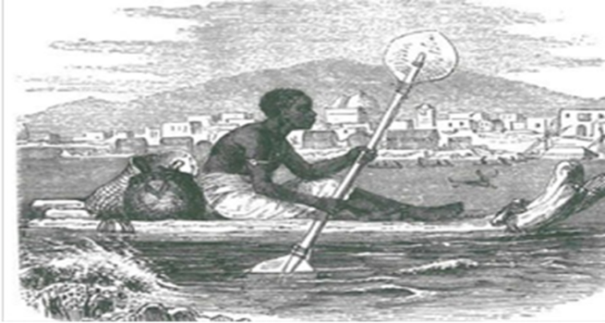
Fig: Ancient boat (Image Credit: www.vht-online.de)
The Mankind paddled round for 35,000 years – just like the Indians and then they began using oars. They oared round for several thousand years – namely, up to 3,000 B.C. until the sails were discovered, supposedly in Egypt (Egyptian dhows).
Fig: Egyptian Dhow(image credit: ohemesatas.keep.pl)
Finally, more than just the River of Nile and the coastal regions of the Red and Mediterranean Seas could be explored by the ancient seafarers. They could then set off on voyages crossing the seas and circling the continents. For a long time, the seamen couldn’t give up using the oar and combined the oar with the sail.
The ships got bigger and bigger during the famous Babylonian king Hammurabi (1792 A.D.-1750 A.D.) and the oars were completely done away with. As the history says, mankind sailed almost 5,000 years – until the year 1770 A.D.
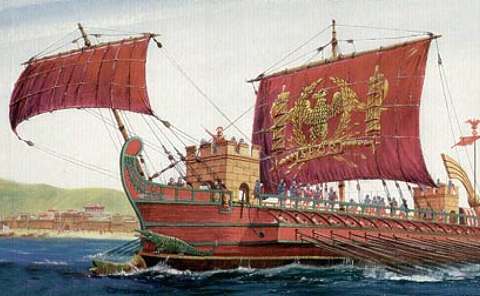
Fig: Roman warship with sail and oars around 200 B.C (Image Credit: www.twcenter.net)
So, after the Egyptian Dhows, the Roman Triremes, Spanish Galleons, British men of war, clipper ships like the White Cloud, Robert Fulton’s steam engine, paddle wheel riverboats, Brunel’s propeller and the venerable petrol and diesel engines came on the history one after another. But it wasn’t until the 20th century that marine propulsion hit its stride.
There were certainly attempts at interim solutions. This illustration is not a comic drawing but rather the then contemporary depiction of a submarine propelled by muscle power, which sank the “Housatonic” in 1864.
Fig: Muscle Powered Submarine “H.L. Hunley” on 17.02.1864 while attacking the “Housatonic” (Image credit: www.vht-online.de)
When James Watt further developed the steam engine for a short time thereafter, it could be built into a ship.
Fig: Full-view of a 2-stage steam engine (Image credit: www.vht-online.de)
At this period in time, the propeller had not yet been invented and, what was more convenient to make use of than the old-familiar paddle-wheel of the flour and lumber mills.
The paddle-wheel propelled the ship and the steam engine drove the paddle-wheel. The coal-fired boilers provided the steam for the steam engine.
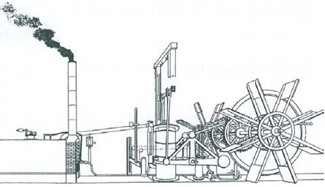
Fig: “Contemporary” depiction of propulsion (steam engine and paddle-wheel) of the steamboat “Claremont” (Image credit: www.vht-online.de)
Mankind didn’t throw the sail overboard and install a steam engine, rather one slowly felt his way forward – the ships had a sail and a steam engine with a paddle-wheel (later a propeller, as well).
Fig: Steamship “Great Eastern” around 1860. The ship had 6 masts, 2 paddle-wheels and a four-bladed propeller. (Image credit: www.vht-online.de).

Fig: Steamship “Helena Sloman” around 1850. The ship had a full set of sails and a propeller (Image credit: www.vht-online.de).
In the year 1827, Joseph Ressel had the ship propeller patented. The iron propeller was a great improvement as compared with the wooden paddle-wheel with its many fragile pieces. Even more importantly, the propeller was able to be adapted to all of the following types of propulsion and output standards of today.
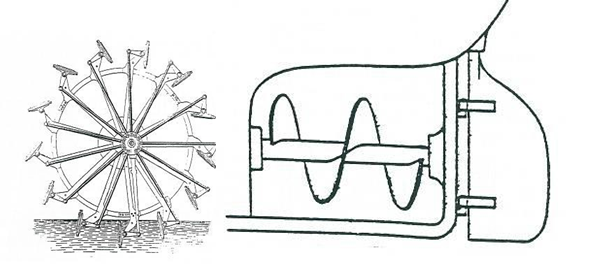
Fig: Depictions of a paddle-wheel and “prototype” of a propeller. (Image credit: www.vht-online.de)
In the beginning inboard propeller shaft bushings were wood, machined from the rock hard tropical Lignum Vitae tree. That is until the 1920s when a Californian mining engineer improvised a bearing using a chunk of common rubber steam hose pressed inside a sleeve. The modern day Cutless bearing replete with flutes and naval bronze tubing was born. Cutless bearing technology advanced during the WW II battle for the Coral Sea when reverberations from explosions in the water hardened the rubber in Cutless bearings. Battleship propeller shafts locked up solid. Rigid rubber was soon replaced by resilient nitrile rubber.
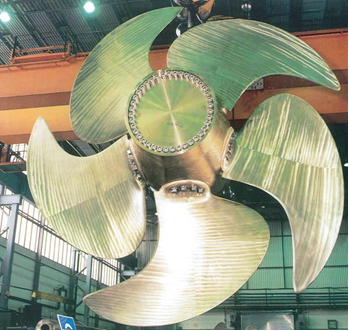
Fig: 5-bladed control pitch propeller for a container ship (Image credit: www.vht-online.de)
Meanwhile, propellers are built which can manage 120,000 hp and weigh over 130 tonnes having a diameter of just short of 10 metres. Here, the limit of possibility certainly seems to have been reached.
In the year 1876, thus 130 years ago – the combustion engine was invented by Nikolaus Otto. It had to be driven with benzene, which at the time had to be purchased at the chemist’s with high prices.
The combustion engine was, thus, discovered, but it wasn’t originally good for ship propulsion because it used too much expensive petrol.
Even 50 years before the invention of the Otto motor, the Frenchman, Carnot, described a thermo-dynamic cyclic process with theoretically the highest possible degree of efficiency.
With the above in mind, Rudolf Diesel developed a combustion engine which operated according to the Carnot-principle and had the same patented in 1892. The ‘diesel engine’ reached a spectacularly high efficiency of 20, then 30, then 40 and finally 45 %.
In 1907 Norwegian Ole Evinrude had invented the first gasoline-powered outboard motor which was built of steel and brass and had a crank on the flywheel to start the two-cycle engine. It was said, the invention inspired by his true love. Rowing a boat on a hot summer’s day to bring vanilla ice cream to his beloved girlfriend, Bess, the vanilla melted before he could get back to the island. Necessity is the mother of invention. Truth be told, some antique outboard cognoscenti dispute whether the Evinrude was first, or simply one of the better publicized enterprises. A little known sidebar, at about the same time Ole helped Harley Davidson engineer its first carburettor.
Around 1910, one began to build diesel motors into ships as the main source of propulsion. The entire diesel engine took up approx. as much as three boilers and thereby, replaced a steam propulsion system, which perhaps was comprised of 2 turbines, 15 boilers and countless auxiliary units and, thereby, required 30 % less fuel.
From 1910 to today, the diesel engine has gone through an unparalleled technical development. Similar to the propeller, the diesel engine was able to be adapted to every demand on size and output performance.
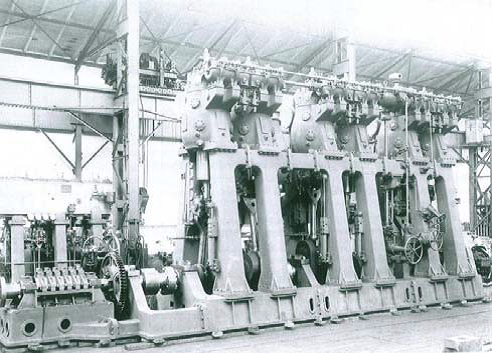
Fig: View of a large two-stroke diesel engine around 1912 (1,500 hp at 120 RPM) (Image credit: www.vht-online.de)
the nuclear powered merchant vessels which were built in the 60’s of the previous century – namely, the Savannah (USA), the Otto Hahn (Germany) and the Mutsu (Japan). All three ships were powered by propellers, which, in turn, were driven by steam turbines typical of merchant ships – only that the steam was not produced in oil-fired boilers but rather in a so called pressurised-water reactor.
Fig: MS Otto Hahn, Germany (image credit: www.junglekey.com)
The ships were extremely expensive and uneconomical and at their time they were only able to touch at very few ports worldwide owing to a lacking acceptance in the population. They also required a large number of well-trained crew members. The “Otto Hahn” had e.g. a regular crew of nearly 60 men plus 35 scientists on board.
Ship diesel engines of today are available in every size and output class up to 135,000 hp. They are extremely reliable, and the so- called specific fuel consumption is unbeatably low with 119 g/hph – at its time, the steam engine consumed approx. 700 g/hph.
The diesel engine has many advantages. It has displaced every other type of propulsion in shipping. Today, approx. 90% of all merchant vessels are propelled by diesel engines world-wide.
The technology has been developing day by day with the uprising demands of ship owners, IMO rules and regulations and the global climate change issues.
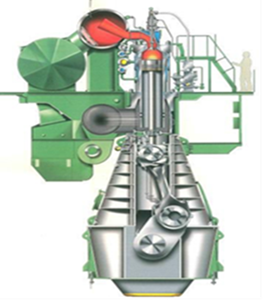
Fig: Modern 2 Stroke Diesel Engine (Source: MAN B&W)
The Wartsila-Sulzer RTA96-C turbocharged two-stroke diesel engine is the most powerful and most efficient ship’s engine in the world today. The Aioi Works of Japan’s Diesel United, Ltd built the first engines and is where some of these pictures were taken.

Fig: Wartsila-Sulzer RTA96-C (image credit: www.gcaptain.com)
It is designed to provide the motive force for a variety of super tankers and container ships, it comes in 6 cylinder in-line through to a whopping 14 cylinder version. The engine weighs in at 2,300 tons and is capable of delivering 109,000 horsepower with the specific fuel consumption 171 g/(kW·h).
This is not the end of innovations of marine propulsion engines! Now mankind is focused to develop more and more technology innovations for Green House Gas (GHG) emissions control and energy efficiency measures in marine propulsion system to protect this green earth.
Sources:
1. The story of Noah’s ark from The Holy Quran.
2. Bernd Röder’s speech on VHT general Meeting in 2008, www.vht-online.de
3. History of Ships by Jean Vaucher (2014)
4. www.marineenginedigest.com
5. www.wikipedia.org
6. www.gcaptain.com
_____________
Mohammud Hanif Dewan(31) is a maritime education professional and working as a Lecturer at Malaysian Maritime Academy (ALAM). He is an Assistant Consultant of IMO. He sailed as the Chief Engineer onboard oil & chemical tankers in multinational companies. He also worked for developing and preparing of syllabuses for marine engineering pre-sea and post-sea courses of Department of Shipping, Bangladesh as per STCW 2010.



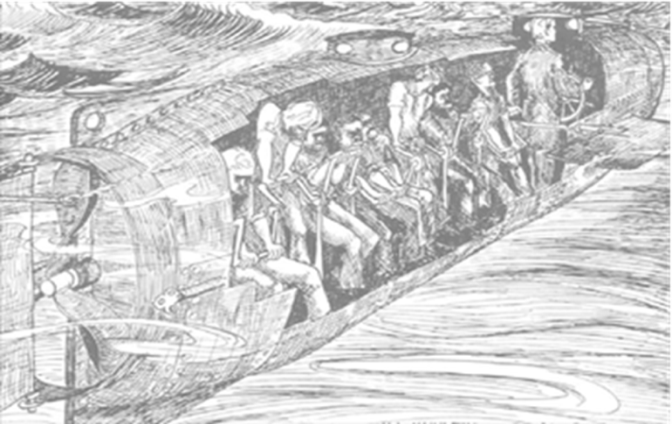






![[নোঙর 2016] Message From the President](http://bdmariners.org/wp-content/uploads/2016/05/R-Qader_Message-220x180.jpg)


![[নোঙর 2016] আমার সেরা বিদেশ ভ্রমন : নাফিসা মাশহুরা ইরা](http://bdmariners.org/wp-content/uploads/2016/06/Dubai-city-tour-70x70.jpg)




Recent Comments